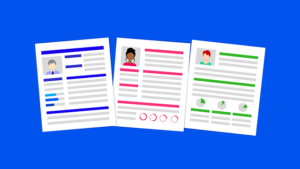 Today’s guest blogger is Keith Grafman, Founder and Principal of Creative Content Consulting, LLC. CCC positions digital identity for your career, dating, and business, with a consistent presence across your digital footprint. For more information, visit: www.CreativeContentConsulting.com
Today’s guest blogger is Keith Grafman, Founder and Principal of Creative Content Consulting, LLC. CCC positions digital identity for your career, dating, and business, with a consistent presence across your digital footprint. For more information, visit: www.CreativeContentConsulting.com
Wondering why your resume that’s chock full of color, graphics, pictures, unique characters and symbols isn’t landing you interviews? The culprit is most likely all of those fancy bells and whistles—they typically work against you.
Don’t let this discourage you from taking a creative approach to your resume and career positioning because you do need to individualize yourself, but it’s important to avoid confusing the parsing systems. Rather than leading with aesthetics, focus on articulating value.
For those of you that have heard of ATS systems, AKA Application Tracking Systems, that’s not the only part of your job application process that should concern you. There are also systems referred to as parsing systems. The simple explanation of a parsing system is the technology responsible for analyzing and interpreting your digital application/resume data to be organized and reviewed thereafter. More specifically, have you ever noticed when you’re prompted to submit/attach your resume/CV, immediately thereafter, a whole bunch of information (such as your name, phone number, city/state, etc.) populates? That’s a parsing system at work.
When an applicant is prompted to attach a resume/CV, there are typically options to submit a variety of formats, e.g. Microsoft Word, PDF, etc.
There’s a lot of debate surrounding the use of Microsoft Word vs. PDF documents for the digital application process—the fact is, both file formats have value.
The benefits of submitting a PDF-version of your resume:
- Typically an accepted format for job application submissions
- Keeps your resume formatting secured for submission process
- Protects your data, organization and formatting within the document
The benefits of having a Word-version of your resume:
- An easy-to-reference version that can be modified as needed
- Some parsing systems may require the submission of a Word formatted document
Ideally, it’s optimal to have both a Word and PDF version of your resume, so you are able to:
- Modify/add any relevant new details, accomplishments, etc. as your career progresses
- Control the context and visual presentation of your career-positioning assets
If you find yourself confused about which resume file format is optimal for a job application submission, my suggestion would be to submit as a PDF whenever it’s an acceptable file format—This way, you’ll be able to protect your resume’s formatting and content.
 Our guest blogger is Jason Elias of Elias Recruitment in Sydney, Australia. Elias Recruitment is a specialist legal recruitment consultancy, finding lawyers for law firms, not for profits and corporates, across Australia. Jason is the Chairman-ELect of the NPAworldwide Board of Directors and received our Chairman’s Award in 2014. Jason is also a Fellow of the peak recruitment industry body in Australasia the RCSA (Recruitment & Consulting Services Association).
Our guest blogger is Jason Elias of Elias Recruitment in Sydney, Australia. Elias Recruitment is a specialist legal recruitment consultancy, finding lawyers for law firms, not for profits and corporates, across Australia. Jason is the Chairman-ELect of the NPAworldwide Board of Directors and received our Chairman’s Award in 2014. Jason is also a Fellow of the peak recruitment industry body in Australasia the RCSA (Recruitment & Consulting Services Association).
